 Global| Oct 03 2008
Global| Oct 03 2008Largest Decline in U.S. Payrolls Since Early 2003
by:Tom Moeller
|in:Economy in Brief
Summary
Nonfarm payrolls declined 159,000 during September, according to the Bureau of Labor Statistics. The latest decline was the largest during each of the last nine months and it exceeded Consensus expectations for a 105,000. It was [...]
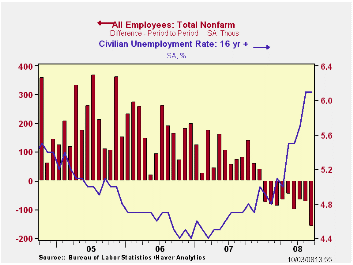
Nonfarm payrolls declined 159,000 during September, according to the Bureau of Labor Statistics. The latest decline was the largest during each of the last nine months and it exceeded Consensus expectations for a 105,000. It was accompanied by modest revisions to prior months' figures. Payrolls have fallen by 760,000, or by 0.6%, this year.The latest figures were depressed by Hurricanes Gustav & Ike.
During the last three months payrolls fell at a 0.9% annual rate. That is the quickest rate of decline during this cycle but it compares to a rate in excess of -2.0% by the end of the 2001 recession.
The length of the average workweek slipped to 33.6 hours.
Combined with recent declines in employment, an unchanged workweek for
3Q versus 2Q left aggregate hours-worked down at a 2.0% rate last
quarter. That suggests no growth in real 3Q GDP assuming a 2.0% rate of
advance in worker productivity.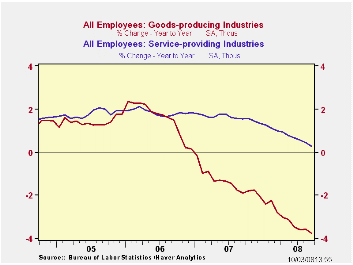
The unemployment rate held steady at 6.1% last month and that equaled expectations. Nevertheless, it was the highest level since September of 2003.
Household sector employment fell 222,000 (-0.7% y/y) after an unrevised 342,000 worker August decline. It was the seventh monthly decline this year. The level of the unemployed rose 101,000 (30.8% y/y) following a 592,000 August increase. The labor force fell 121,000 (+0.8% y/y) during September. The labor force participation rate slipped to 66.0% after three months at 6.1%. It was 66.0% during all of last year and 66.2% in 2006. The participation rate amongst adult men was unchanged at 75.8%, about the same as averaged last year, but amongst adult women, it fell to 60.8% which near the lowest level this year.
The average duration of unemployment increased by one full week to 18.4. The median duration of unemployment, however, rose to a lesser 10.2 weeks, up from 8.5 weeks during all of last year. The number of those unemployed for more than 27 weeks increased 9.1% (56.9% y/y), about as it did during August.
From the establishment survey, the number of private sector
jobs fell 168,000 (-0.7% y/y). Private service sector industries fell
91,000 (0.0% y/y), the largest decline since early 2003. Nevertheless,
September logged the eighth decline, and the largest, in the last nine
months. Employment in trade, transportation & utilities fell by
58,000 (-1.3% y/y). Retail sector jobs plunged 41,100 (-1.6% y/y) with
motor vehicle & parts dealers accounting for roughly a quarter
of the decline. Jobs in the information sector fell 3,000 last month
(-1.7% y/y) while financial sector jobs fell 17,000 (-1.3% y/y). The
professional & business service industry shed 27,000 (0.9% y/y)
jobs. Temporary help services jobs which often are a leading indicator
of employment growth, fell 24,100 (-9.1% y/y). These declines were
somewhat offset by continued positive employment growth in the
education & health industries, up 25,000 (3.1% y/y) during
September.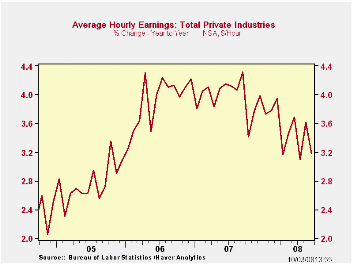
Factory sector jobs fell 51,000 after a 56,000 worker decline during August (-3.2% y/y). Motor vehicle & parts jobs fell 18,200 (-14.1% y/y) but computer & electronic product jobs were unchanged (-0.9% y/y). In the nondurables sector employment fell 14,000 (-2.3% y/y).
Construction sector employment fell another 35,000 during September which was the largest decline in three months.
Government sector jobs moved higher by 9,000 (1.4% y/y) led by a 5,000 (1.4% y/y) worker increase in state government hiring. Federal government hiring rose by 3,000 (1.1% y/y) while local governments added 1,000 (1.5% y/y) workers.
The one month diffusion index, which measures the breadth of job gain or loss (50 is the break-even level), fell to its lowest level of this cycle (38.1%). The three-month index also was at its cycle low (36.1%) and the three-month figure for the factory sector was even weaker at 20.8%.
Average hourly earnings rose just 0.2%. Factory sector earnings reversed their August decline and rose 0.2% (2.6% y/y) while private service sector earnings also rose 0.2% (3.4% y/y).
| Employment: 000s | September | August | July | Y/Y | 2007 | 2006 | 2005 |
|---|---|---|---|---|---|---|---|
| Payroll Employment | -159 | -73 | -67 | -0.4% | 1.1% | 1.8% | 1.7% |
| Previous | -- | -84 | -60 | -- | 1.3% | 1.9% | 1.7% |
| Manufacturing | -51 | -56 | -40 | -3.2% | -1.9% | -0.5% | -0.6% |
| Construction | -35 | -31 | -23 | -6.1% | -1.0% | 4.9% | 5.2% |
| Average Weekly Hours | 33.6 | 33.7 | 33.7 | 33.8 (Sept. '07) | 33.8 | 33.9 | 33.8 |
| Average Hourly Earnings | 0.2% | 0.4% | 0.3% | 3.4% | 4.0% | 3.9% | 2.7% |
| Unemployment Rate | 6.1% | 6.1% | 5.7% | 4.7% (Sept. '07) | 4.6% | 4.6% | 5.1% |
by Tom Moeller October 3, 2008
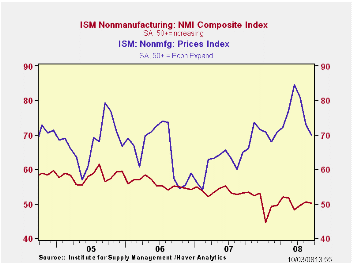
The September Composite Index for the nonmanufacturing sector from the Institute for Supply Management slipped to 50.2 from an unrevised 50.6 during August. The figure about matched Consensus expectations.
The nonmanufacturing business activity sub-index, however, rose to 52.1 which was its highest level since May. Since the series' inception in 1997 there has been a 48% correlation between the level of the business activity index for the nonmanufacturing sector and the Q/Q change in real GDP for the services and the construction sectors.
The new orders sub-index also rose last month to 50.8 which was the highest level since May.
The employment index, conversely, fell m/m to 44.2 which was
the lowest level since June. Since the series' inception in 1997 there
has been a 56% correlation between the level of the ISM
nonmanufacturing employment index and the m/m change in payroll
employment in the service-producing plus the construction industries.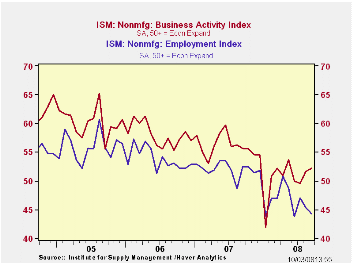
Pricing power also slipped to 70.0 which was its lowest level since March. Since inception ten years ago, there has been a 60% correlation between the price index and the q/q change in the GDP services chain price index.
Beginning with the January 2008 Nonmanufacturing Report On Business®, the composite index is calculated as an indicator of the overall economic condition for the non-manufacturing sector. It is a composite index based on the diffusion indexes for four of the indicators (business activity, new orders, employment and supplier deliveries) with equal weights. The latest report from the ISM can be found here.
ISM surveys more than 370 purchasing managers in more than 62 industries including law firms, hospitals, government and retailers. The nonmanufacturing survey dates back to July 1997.
| ISM Nonmanufacturing Survey | September | August | September '07 | 2007 | 2006 | 2005 |
|---|---|---|---|---|---|---|
| Composite Index | 50.2 | 50.6 | 53.2 | 53.5 | 55.7 | 58.0 |
| Prices Index | 70.0 | 72.9 | 65.0 | 63.8 | 65.3 | 68.0 |
by Robert Brusca October 3, 2008
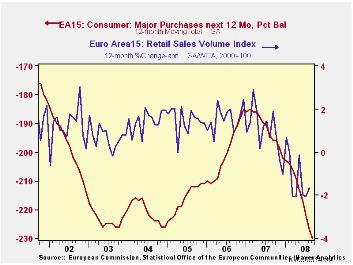
Retail sales in the Euro Area rose in August. The rise was small but it marks the second monthly rise in a row. Still the growth rates over 3 months, 6 months and 12 months are all hovering in the -2% range (saar) for the Area. The bottom of the table shows country by country results for Germany, Italy and the UK. The volatility in country level sales has been substantial. Germany saw sales volume spurt by 4.1% (ex-auto) in August. UK sales volume rose by 1.2%. Still over three months UK sales are off at an 8.1% annual rate. German sales over three months are up at a +2.4% pace. There is a lot of volatility in Europe. While this report seems to show some resiliency, consumer plans to buy still seem to be skewed sharply lower (see chart). Consumer sentiment remains weak and the industrial sectors across Europe are still weakening. The rise in retail sales in August seems to be more of an anomaly than proof of resiliency.
| Euro Area 15 Retail Sales Volume | ||||||
|---|---|---|---|---|---|---|
| Aug-08 | Jul-08 | Jun-08 | 3-Mo | 6-MO | 12-Mo | |
| Euro Area 15 Total | 0.3% | 0.1% | -0.8% | -1.8% | -2.1% | -1.7% |
| Food | 0.7% | -0.5% | -0.7% | -2.0% | -2.6% | -2.1% |
| Nonfood | 0.1% | 0.5% | -0.9% | -1.0% | -1.5% | -1.4% |
| Textiles | #N/A | 2.4% | -2.7% | 24.9% | -0.2% | -0.1% |
| Books, news, etc | #N/A | 1.0% | -1.1% | -1.1% | -2.4% | -0.4% |
| Pharmaceutical | #N/A | 0.0% | 0.5% | 0.6% | 0.8% | 1.5% |
| Other nonspecialized stores | #N/A | 1.1% | -1.8% | -0.7% | -2.0% | -1.1% |
| Mail Order | #N/A | 2.9% | -1.3% | 2.7% | -0.3% | 0.1% |
| Country detail;Volume | ||||||
| Germany: Vol ex Auto | 3.1% | -1.0% | -1.5% | 2.4% | -0.6% | 0.1% |
| Italy (Total; Value) | #N/A | 0.6% | -0.4% | 1.8% | 0.4% | 0.6% |
| UK (EU):Vol | 1.2% | 0.9% | -4.2% | -8.1% | 1.9% | 3.4% |
| Shaded areas calculated on a one-month lag due to lagging data | ||||||
| The EA 15 countries are Austria, Belgium, Cyprus, Finland, France, Germany, Greece, Ireland, Italy, Luxembourg, Malta, Netherlands, Portugal, Slovenia and Spain. | ||||||
Tom Moeller
AuthorMore in Author Profile »Prior to joining Haver Analytics in 2000, Mr. Moeller worked as the Economist at Chancellor Capital Management from 1985 to 1999. There, he developed comprehensive economic forecasts and interpreted economic data for equity and fixed income portfolio managers. Also at Chancellor, Mr. Moeller worked as an equity analyst and was responsible for researching and rating companies in the economically sensitive automobile and housing industries for investment in Chancellor’s equity portfolio. Prior to joining Chancellor, Mr. Moeller was an Economist at Citibank from 1979 to 1984. He also analyzed pricing behavior in the metals industry for the Council on Wage and Price Stability in Washington, D.C. In 1999, Mr. Moeller received the award for most accurate forecast from the Forecasters' Club of New York. From 1990 to 1992 he was President of the New York Association for Business Economists. Mr. Moeller earned an M.B.A. in Finance from Fordham University, where he graduated in 1987. He holds a Bachelor of Arts in Economics from George Washington University.






